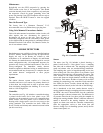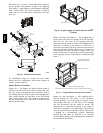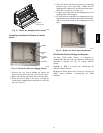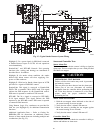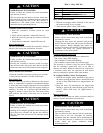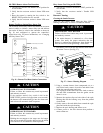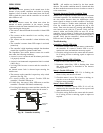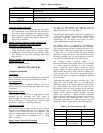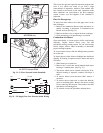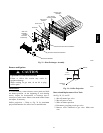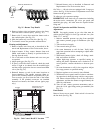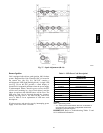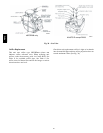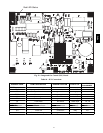
24
Table 3 – Detector Indicators
CONTROL OR INDICATOR DESCRIPTION
Magnetic test/reset switch
Resets the sensor when it is in the alarm or trouble state. Activates or tests the sensor when it is in
the normal state.
Alarm LED Indicates the sensor is in the alarm state.
Trouble LED Indicates the sensor is in the trouble state.
Dirty L ED
Indicates the amount of environmental compensation used by the sensor
(flashing continuously = 100%)
Power LED Indicates the sensor is energized.
Controller’s Power LED is Off
1. Make sure the circ uit supplying power to the control-
ler is operational. If not, make sure JP2 and JP3 are
set correctly on the controller before applying power.
2. Verify that power i s applied to the controller’s supply
input terminals. If power is not present, replace or re-
pair wiri ng as required.
Remote Test/Reset Station’s Trouble LED Does
Not
flash When Performing a Dirty Test, But
the
Controller’ s Trouble LED
Does
1. Verify that the remote test/station is wired as shown
in Fig. 26. Repair or replace loose or missing wiring.
2. Configure the sensor dirty test to activate the control-
ler’s supervision relay. See “Changing sensor dirty
test ope ration.”
Sensor’s Tr ouble LED is On, But the Controller’
s
Trouble LED is
OFF
Remove JP1 on the controller.
PROTECTIVE DEVI CES
Compressor Protection
Overcurrent
Each compressor has internal linebreak motor protection.
Reset is automatic after compressor motor has cooled.
Overtemperatur
e
Each compressor has an internal protector to protect it
against excessively high discharge gas temperatures. Reset
is automatic.
High Pressure
Switch
Each system is provided with a high pressure switch
mounted on the discharge l ine. The switch is
stem-- mounted and brazed into the discharge tube. Trip
setting is 630 psig +/-- 10 psig (4344 +/-- 69 kPa) when
hot. Reset is automatic at 505 psig (3482 kPa).
Low Pressure
Switch
Each system is protected against a loss of charge and low
evaporator coil loading condition by a low pressure switch
located on the suction line near the compressor. The
switch is stem--mounted. Trip setting i s 54 psig +/ -- 5 psig
(372 +/-- 34 kPa). Reset is automatic at 117 +/-- 5 psig
(807 +/-- 34 kPa).
Supply (Indoor) Fan Motor Pr
otection
Disconnect and lockout power when servicing fan motor.
2.9 and 3.7 bhp motors are equipped with an
overtemperature or protection device. The type of device
depends on the motor size. See Table 4.
The High Static option supply fan motor is equipped with
a pilot--circuit Thermix combination overtemperature/
overcurre nt protection device. This device resets
automatically. Do not bypass this switch to correct
trouble. Determine the cause and correct it.
The Thermik device is a snap--action overtemperature
protec tion device that is imbedded in the motor windings.
It is a pilot--circuit device that is wired into the unit’s 24--v
control circuit. When this switch reaches its trip setpoint,
it opens the 24--v control circuit and causes all unit
operation to cease. This device resets automatically when
the motor windings cool. Do not bypass this switch to
correc t trouble. Determine the cause and correct it.
The Exter nal motor overload device is a
specially--calibrated circuit breaker that is UL recognized
as a motor overload controller. It i s an overc urrent
device. When the motor current exceeds the circuit
breake r setpoint, the device opens all motor power leads
and the motor shuts down. Reset requires a manual reset
at the overload switch. This device (designated IFCB) is
loca ted on the side of the supply fan housing, behind the
fan access panel.
Troubleshooting supply fan motor overload trips: The
supply fan used in 48TC units is a forward--curved
centrifugal wheel. At a constant wheel speed, this wheel
has a characteristic that causes the fan shaft load to
DECREASE when t he static pressure in the unit--duct
system increases and to INCREASE when the static
pressure in the unit--duct system decreases (and fan
airflow rate increases). Motor overload conditions
typically develop when the unit is operated with an access
panel removed, with unfinished duct work, in an
econom izer--open mode, or a leak develops in the duct
system that allows a bypass back to unit return opening.
Table 4 -- Overcurrent Device Type
Motor Size (bhp) Overload Device Reset
1.7 Internal Linebreak Automatic
2.4 Internal Linebreak Automatic
2.9 Thermik Automatic
3.7 Thermik Automatic
4.7 External
(Circuit Breaker)
Manual
48TC




